Abstract
When herpes simplex virus was inoculated into the flank of a BALB/c mouse by scarification, the local replication of virus was followed by the establishment of an acute ganglionic infection. The subsequent centrifugal spread of this virus along nerves to the skin of the whole dermatome led to the development of a bandlike "zosteriform" rash. This represents a highly reproducible system in which virus travels through the nervous system synchronously in large numbers of animals. The transection of peripheral nerves at various times after infection showed that the virus had completed the round trip 60 h after inoculation into the upper flank and was detectable as infectious virus by 74 h postinfection. After the administration of virus, neutralizing but not nonneutralizing antibodies prevented the development of the zosteriform rash. The target epitopes of the protective antibodies were not confined to a single glycoprotein. Neutralizing antibody was effective even when given up to 60 h postinfection and was protective even when administered after sensory neurotomy at this time. Antibody was therefore able to prevent clinically and virologically detectable infection of the skin, presumably by acting peripherally on virus emerging from nerve endings. A quantitative estimate of the action of one of the neutralizing monoclonal antibody preparations, AP7, showed that high titers (several times higher than those normally found in immune mice) were needed to prevent this type of infection. These results are discussed in relation to antibody prophylaxis.
Full text
PDF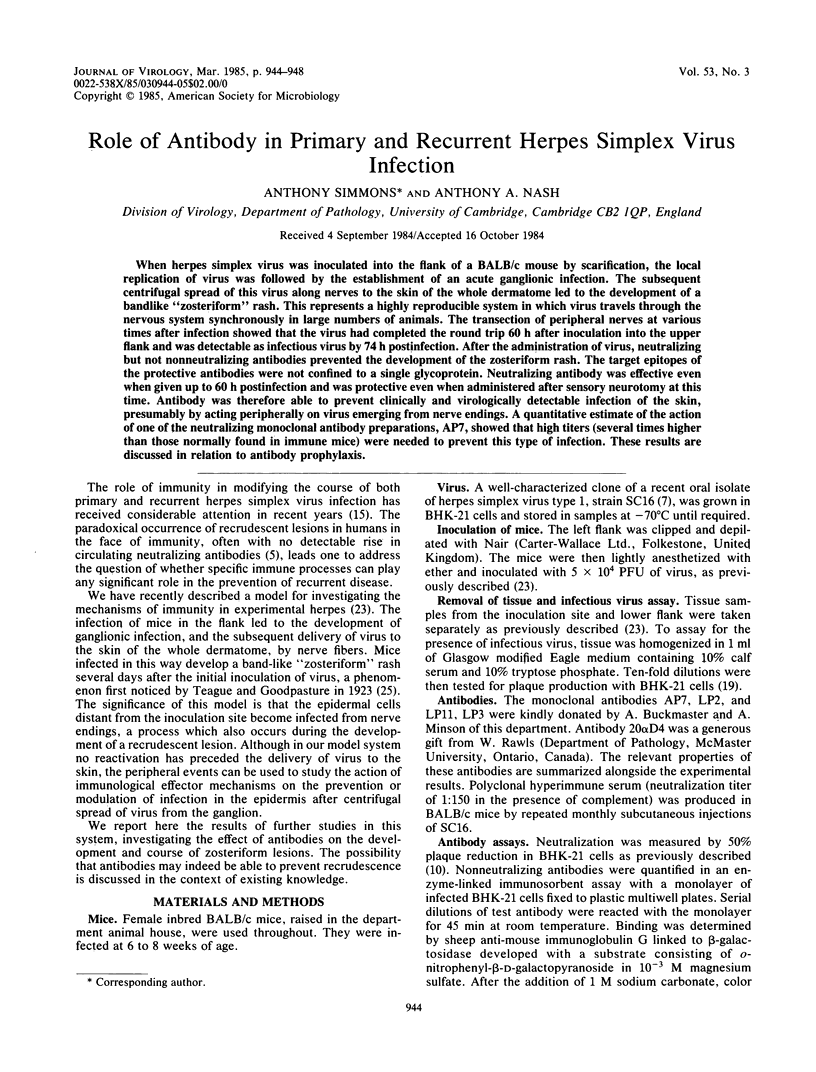
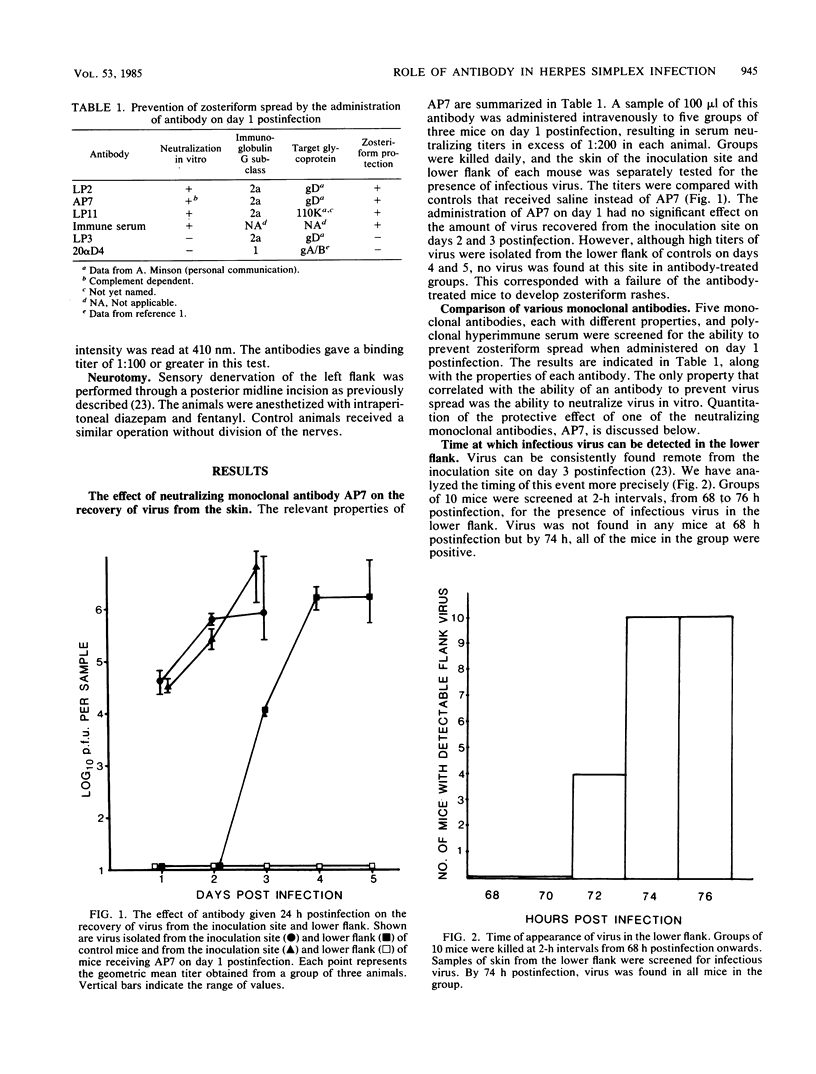
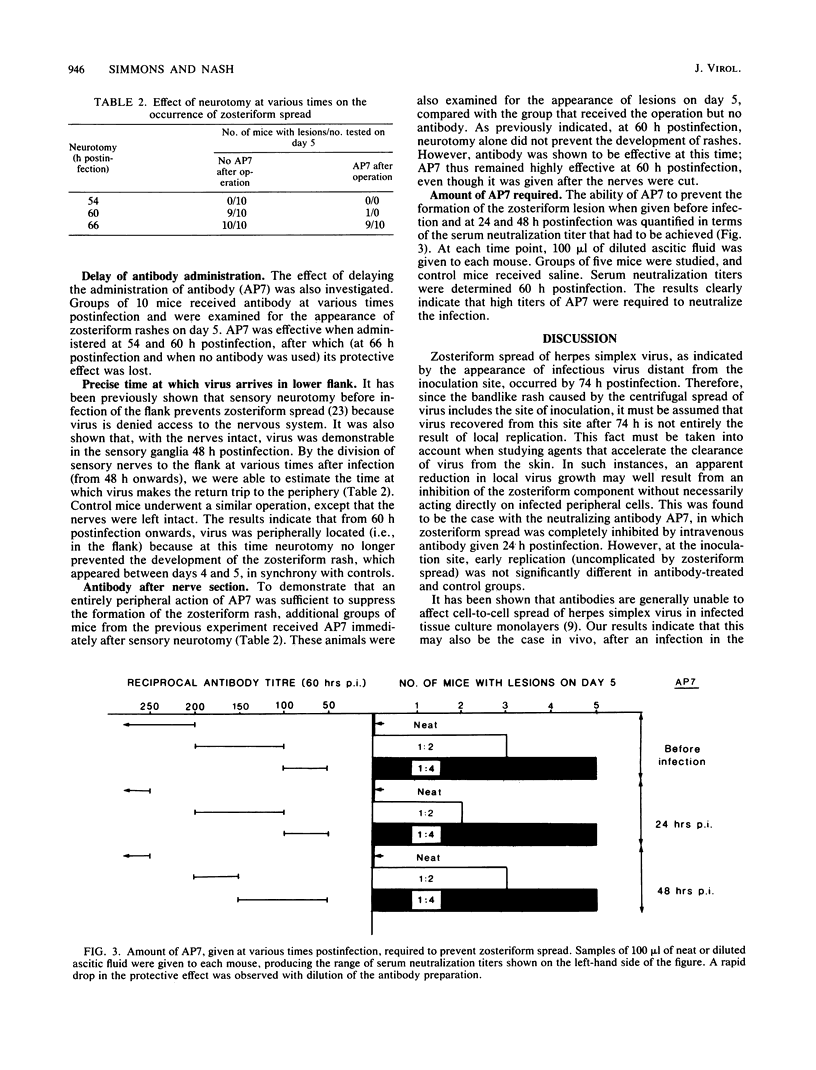
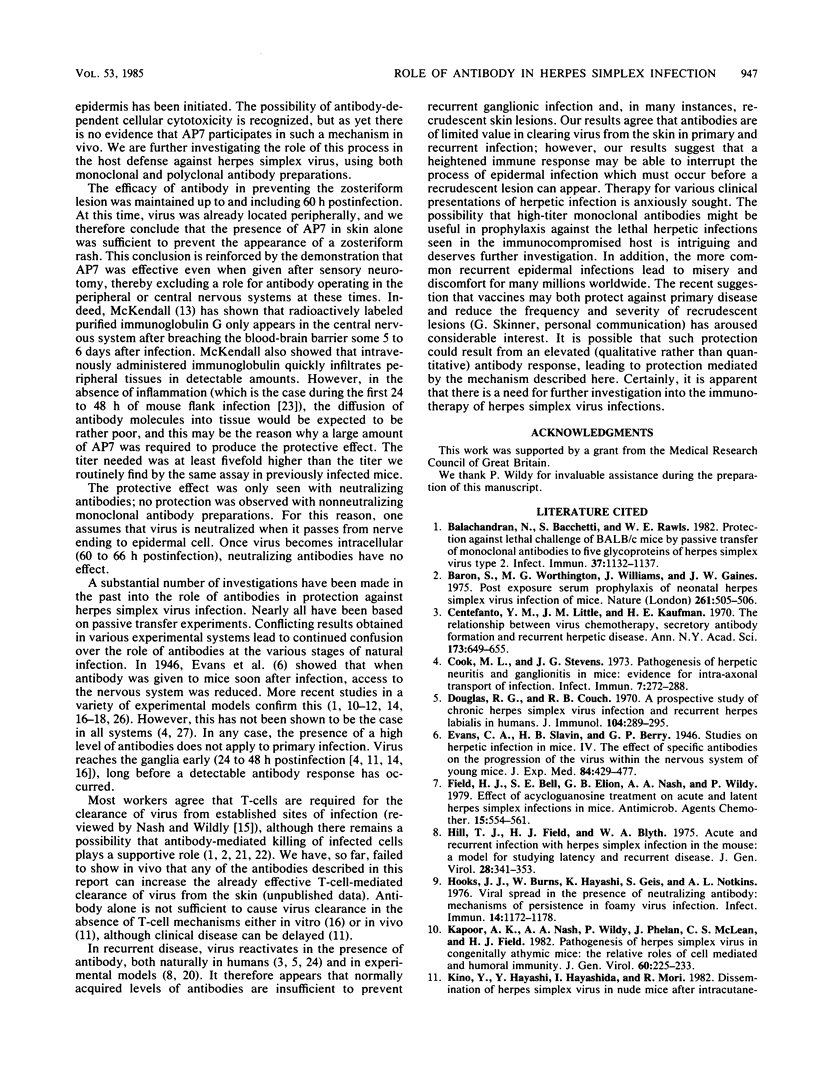
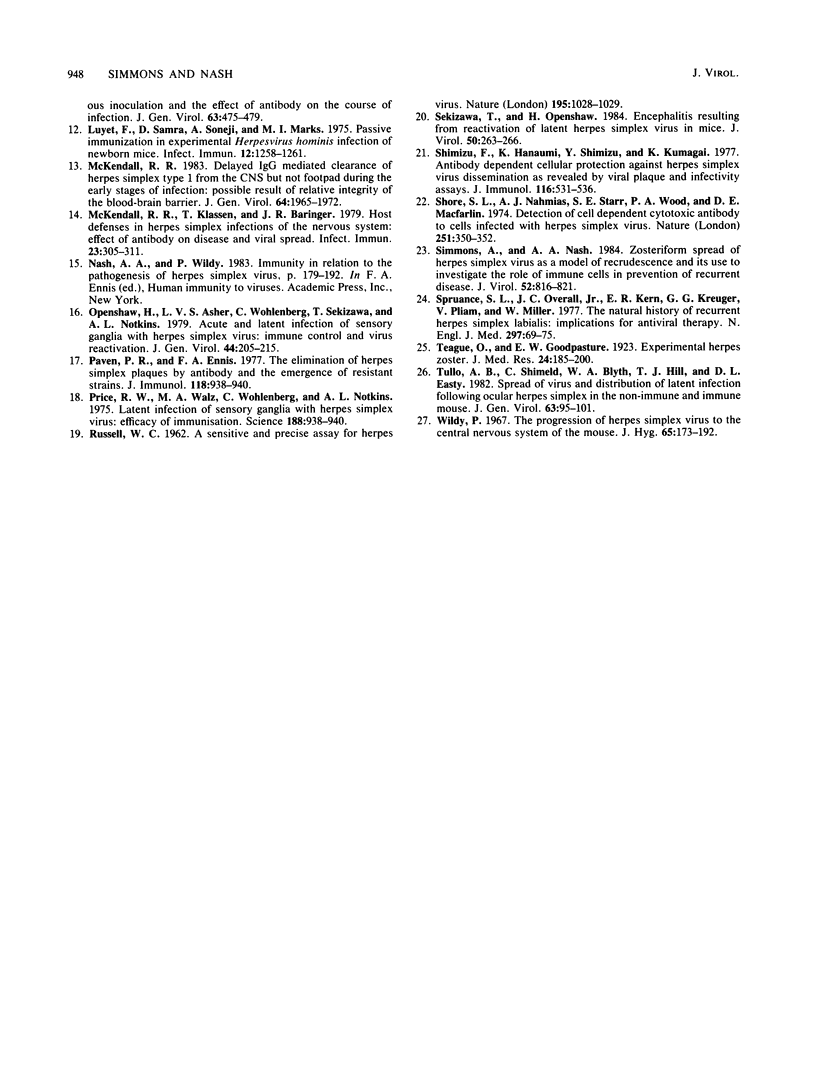
Selected References
These references are in PubMed. This may not be the complete list of references from this article.
- Balachandran N., Bacchetti S., Rawls W. E. Protection against lethal challenge of BALB/c mice by passive transfer of monoclonal antibodies to five glycoproteins of herpes simplex virus type 2. Infect Immun. 1982 Sep;37(3):1132–1137. doi: 10.1128/iai.37.3.1132-1137.1982. [DOI] [PMC free article] [PubMed] [Google Scholar]
- Baron S., Worthington M. G., Williams J., Gaines J. W. Postexposure serum prophylaxis of neonatal herpes simplex virus infection of mice. Nature. 1976 Jun 10;261(5560):505–506. doi: 10.1038/261505a0. [DOI] [PubMed] [Google Scholar]
- Cook M. L., Stevens J. G. Pathogenesis of herpetic neuritis and ganglionitis in mice: evidence for intra-axonal transport of infection. Infect Immun. 1973 Feb;7(2):272–288. doi: 10.1128/iai.7.2.272-288.1973. [DOI] [PMC free article] [PubMed] [Google Scholar]
- Douglas R. G., Jr, Couch R. B. A prospective study of chronic herpes simplex virus infection and recurrent herpes labialis in humans. J Immunol. 1970 Feb;104(2):289–295. [PubMed] [Google Scholar]
- Field H. J., Bell S. E., Elion G. B., Nash A. A., Wildy P. Effect of acycloguanosine treatment of acute and latent herpes simplex infections in mice. Antimicrob Agents Chemother. 1979 Apr;15(4):554–561. doi: 10.1128/aac.15.4.554. [DOI] [PMC free article] [PubMed] [Google Scholar]
- Hill T. J., Field H. J., Blyth W. A. Acute and recurrent infection with herpes simplex virus in the mouse: a model for studying latency and recurrent disease. J Gen Virol. 1975 Sep;28(3):341–353. doi: 10.1099/0022-1317-28-3-341. [DOI] [PubMed] [Google Scholar]
- Hooks J. J., Burns W., Hayashi K., Geis S., Notkins A. L. Viral spread in the presence of neutralizing antibody: mechanisms of persistence in foamy virus infection. Infect Immun. 1976 Nov;14(5):1172–1178. doi: 10.1128/iai.14.5.1172-1178.1976. [DOI] [PMC free article] [PubMed] [Google Scholar]
- Kapoor A. K., Nash A. A., Wildy P., Phelan J., McLean C. S., Field H. J. Pathogenesis of herpes simplex virus in congenitally athymic mice: the relative roles of cell-mediated and humoral immunity. J Gen Virol. 1982 Jun;60(Pt 2):225–233. doi: 10.1099/0022-1317-60-2-225. [DOI] [PubMed] [Google Scholar]
- Kino Y., Hayashi Y., Hayashida I., Mori R. Dissemination of herpes simplex virus in nude mice after intracutaneous inoculation and effect of antibody on the course of infection. J Gen Virol. 1982 Dec;63(2):475–479. doi: 10.1099/0022-1317-63-2-475. [DOI] [PubMed] [Google Scholar]
- Luyet F., Samra D., Soneji A., Marks M. I. Passive immunization in experimental Herpesvirus hominis infection of newborn mice. Infect Immun. 1975 Dec;12(6):1258–1261. doi: 10.1128/iai.12.6.1258-1261.1975. [DOI] [PMC free article] [PubMed] [Google Scholar]
- McKendall R. R. Delayed IgG-mediated clearance of herpes simplex virus type 1 from the CNS but not footpad during the early stages of infection: possible result of relative integrity of the blood-brain barrier. J Gen Virol. 1983 Sep;64(Pt 9):1965–1972. doi: 10.1099/0022-1317-64-9-1965. [DOI] [PubMed] [Google Scholar]
- McKendall R. R., Klassen T., Baringer J. R. Host defenses in herpes simplex infections of the nervous system: effect of antibody on disease and viral spread. Infect Immun. 1979 Feb;23(2):305–311. doi: 10.1128/iai.23.2.305-311.1979. [DOI] [PMC free article] [PubMed] [Google Scholar]
- Openshaw H., Asher L. V., Wohlenberg C., Sekizawa T., Notkins A. L. Acute and latent infection of sensory ganglia with herpes simplex virus: immune control and virus reactivation. J Gen Virol. 1979 Jul;44(1):205–215. doi: 10.1099/0022-1317-44-1-205. [DOI] [PubMed] [Google Scholar]
- Price R. W., Walz M. A., Wohlenberg C., Notkins A. L. Latent infection of sensory ganglia with herpes simplex virus: efficacy of immunization. Science. 1975 May 30;188(4191):938–940. doi: 10.1126/science.166432. [DOI] [PubMed] [Google Scholar]
- RUSSELL W. C. A sensitive and precise plaque assay for herpes virus. Nature. 1962 Sep 8;195:1028–1029. doi: 10.1038/1951028a0. [DOI] [PubMed] [Google Scholar]
- Sekizawa T., Openshaw H. Encephalitis resulting from reactivation of latent herpes simplex virus in mice. J Virol. 1984 Apr;50(1):263–266. doi: 10.1128/jvi.50.1.263-266.1984. [DOI] [PMC free article] [PubMed] [Google Scholar]
- Shimizu F., Hanaumi K., Shimizu Y., Kumagai K. Antibody-dependent cellular protection against herpes simplex virus dissemination as revealed by viral plauqe and infectivity assays. Infect Immun. 1977 May;16(2):531–536. doi: 10.1128/iai.16.2.531-536.1977. [DOI] [PMC free article] [PubMed] [Google Scholar]
- Shore S. L., Nahmias A. J., Starr S. E., Wood P. A., McFarlin D. E. Detection of cell-dependent cytotoxic antibody to cells infected with herpes simplex virus. Nature. 1974 Sep 27;251(5473):350–352. doi: 10.1038/251350a0. [DOI] [PubMed] [Google Scholar]
- Simmons A., Nash A. A. Zosteriform spread of herpes simplex virus as a model of recrudescence and its use to investigate the role of immune cells in prevention of recurrent disease. J Virol. 1984 Dec;52(3):816–821. doi: 10.1128/jvi.52.3.816-821.1984. [DOI] [PMC free article] [PubMed] [Google Scholar]
- Spruance S. L., Overall J. C., Jr, Kern E. R., Krueger G. G., Pliam V., Miller W. The natural history of recurrent herpes simplex labialis: implications for antiviral therapy. N Engl J Med. 1977 Jul 14;297(2):69–75. doi: 10.1056/NEJM197707142970201. [DOI] [PubMed] [Google Scholar]
- Tullo A. B., Shimeld C., Blyth W. A., Hill T. J., Easty D. L. Spread of virus and distribution of latent infection following ocular herpes simplex in the non-immune and immune mouse. J Gen Virol. 1982 Nov;63(Pt 1):95–101. doi: 10.1099/0022-1317-63-1-95. [DOI] [PubMed] [Google Scholar]


